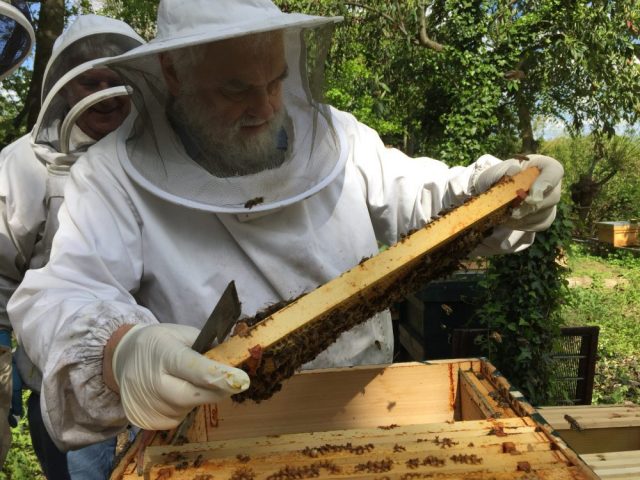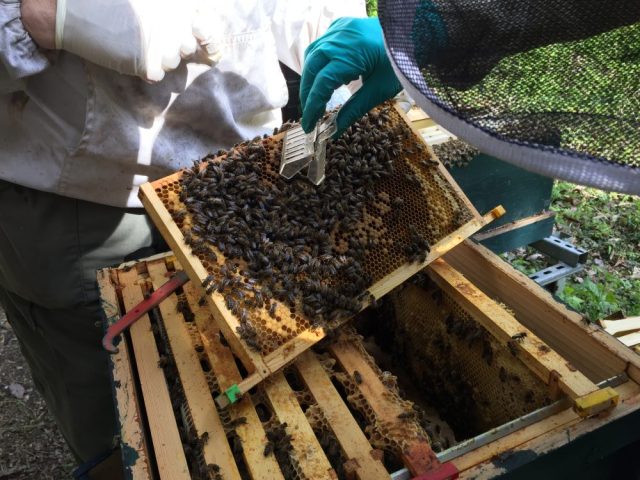On the Saturday before Easter a small but enthusiastic group of us gathered under the shade of the apiary’s trees to watch John Chapple carry out a shook-swarm demo on one of the hives.
Unusually for John, he was actually wearing a veil. This was testimony to the reputation of the chosen bees as particularly curmudgeonly – “bad but prolific” was how John described them. In the end the bees were remarkably patient with us and I believe no-one got stung. Below are some photos showing John going about the process of shaking the bees off their old frames and into a fresh new hive of foundation.
A queen excluder is placed under the brood nest (but above the entrance) to stop the queen absconding. The colony is fed plenty of syrup to help them draw out the foundation and build fresh new comb. The old brood combs are burned, along with any varroa lurking inside the brood. Replacing old combs also helps reduce the chances of the bees getting nasty diseases like AFB and EFB. One of the requirements of keeping bees at the Ealing apiary is to do an annual comb change.
It’s best to find the queen during a shook-swarm so that you can be sure she’s been safely put in the new hive. John had just taken one frame out when Tom’s sharp eyes spotted a magnificent dark queen running up the surface of the next comb. Although she had been marked last summer, she was now unmarked. Either her mark had worn off or the bees had replaced the original queen.
Pat commented that at the Middlesex conference in February one of the speakers suggested that the best way to find the queen is to take out a frame of brood and then immediately look at the surface of the next frame along. This queen had proved that!
Above is a photo of her being captured in a cage before John marked her with a nice pink pen.
I got a few short videos of the shook-swarming process, here’s some links to them:
- John Chapple talks about looking for the queen (23 seconds)
- Capturing the queen in a cage (8 seconds)
- John shaking in a frame of bees (4 seconds)
Someone on Twitter commented about the last video that: “he is shaking an empty frame of foundation with few bees on….pointless showing a shook procedure with no bees on frame. Waste of a video clip” . I thought I’d share that here as fair warning before anyone wastes four seconds of their lives watching it! Good to know my videos have fans.
Official guidance on how to carry out a shook-swarm can be found on the Beebase advisory leaflets page.






Hugely disappointing that YouTube reports “No videos were found”. I was looking forward to squandering that four seconds. I’d made a cuppa and was ready to go. What a let down.
Did John discuss Varroa treatment immediately post-shook swarming? It’s a logical time to decimate the phoretic mites in the fortnight or so they’re building new comb.
David
LikeLike
Aargh sorry I’m out of practice with YouTube! Seem to have fixed it now if you fancy wasting that four seconds after all.
I’ve heard bee inspectors talk about getting rid of the new brood immediately after the shook-swarm but I’ve never had the heart to do it. It’s hard enough destroying all the shook-swarm brood – don’t want to dishearten them just as they’re getting going again!
LikeLike
I don’t think there’s any need to destroy the new brood after the shook swarm starts to get started again. Vaporised Api-Bioxal or oxalic acid will not harm unsealed brood. Alternatively, Apivar or Apistan (assuming the mite population isn’t resistant) could be used as there’s unlikely to be supers on the colony and it will be several weeks until the colony is strong enough to exploit a nectar flow. I’d avoid treatments that are known to deter the Q from laying though …
Cheers
David
LikeLike
Ah I see what you mean. I don’t have the vaporising equipment but can see how that would be a good idea.
LikeLike
Pingback: A shook-swarm demo | How To Raise Bees
Always a joy to see John Chapple at work! The hive he is working on is Alan’s old hive, isn’t it? I always thought those bees were rather nice. I inspected their brood nest and took two frames from the hive (after asking John first, of course) to give to Hope’s hive (when it was Myrtle’s hive) last year, and then I fed and checked the green hive for a few weeks when at the apiary to make sure they were ok with that. They were and Alan’s bees were always very nice to me! 🙂 So maybe it won’t be so bad if we do inherit a new line of queens from those bad bees! 😉 The two brood frames worked a treat last year to help get Myrtle’s colony back on their feet again, so hopefully it will do the same trick this year for Patience’s colony. If nothing else, they’ll have some prolific workers at their disposal to bring in some nectar and pollen for a few weeks.
LikeLiked by 1 person
Pingback: The season of the bee | Mrs Apis Mellifera
Very interesting. I have never done this process. I just change to a new super and replace any empty frame with a new one. My problem is I have a tough time finding the queen.
LikeLike
Changing empty frames gradually is gentler on the bees but not as tough on diseases – there’s pros and cons to every method. We will be doing some gradual changing in our hives this year.
Some queens are right madams to find and like to hide in all sorts of places. The Apiarist has a good blog post on finding the queen – http://theapiarist.org/finding-the-queen/
LikeLike
Thank you for sharing your process and videoing it 🙂
LikeLike
Pingback: A shook-swarm demo | Beginner Beekeeper